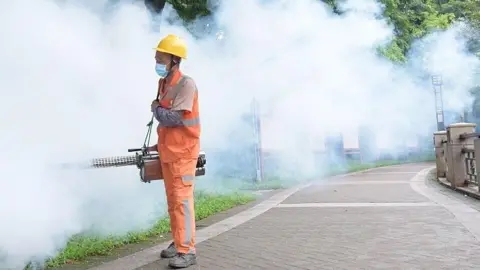Health officials in China’s Guangdong province are scrambling to contain a surge in chikungunya virus cases, with over 7,000 infections reported since July. The mosquito-borne illness, known for causing fever and debilitating joint pain, has prompted authorities to implement strict containment measures reminiscent of those used during the COVID-19 pandemic.
Outbreak Spreads Across Southern China
Foshan, the epicenter of the outbreak, has enforced mandatory hospitalization for infected individuals, requiring patients to remain under mosquito netting until they test negative or complete a week-long isolation. At least 12 other cities in Guangdong have also recorded cases, with nearly 3,000 new infections reported in just the past week.
Hong Kong confirmed its first case—a 12-year-old boy who fell ill after traveling to Foshan. While the virus is not contagious between humans, it spreads when mosquitoes bite infected individuals and then transmit it to others.
Authorities Take Aggressive Action
Guangdong officials have pledged “swift and decisive” steps to curb transmission, including fines of up to 10,000 yuan ($1,400) for residents who fail to eliminate stagnant water—a breeding ground for mosquitoes. Some cities have deployed innovative solutions, such as releasing mosquito-eating fish into lakes and using drones to locate standing water.
In Foshan, authorities have even introduced “elephant mosquitoes,” a larger species that preys on the smaller, disease-carrying insects. Meanwhile, initial quarantine orders for travelers from high-risk areas have since been lifted, sparking debate over the necessity of such measures.
Public Concern Grows
Despite assurances that most cases are mild—with 95% of patients recovering within a week—the outbreak has stirred anxiety among residents unfamiliar with the disease. Online discussions reflect fears over the virus’s potential long-term effects, with some comparing the response to past pandemic restrictions.
“These extreme measures feel excessive,” one social media user commented. “It’s not like infected people are biting others.”
Understanding Chikungunya
First identified in Tanzania in 1952, chikungunya has since spread to over 110 countries, primarily in tropical regions. Symptoms typically appear within a week of infection and include fever, rash, and severe joint pain, which can persist for months or even years in severe cases. While fatalities are rare, newborns, the elderly, and those with chronic conditions face higher risks.
With no cure available, prevention remains the best defense. The World Health Organization recommends eliminating mosquito breeding sites to reduce transmission. As Guangdong intensifies its efforts, the outbreak serves as a reminder of the ongoing threat posed by mosquito-borne diseases.









